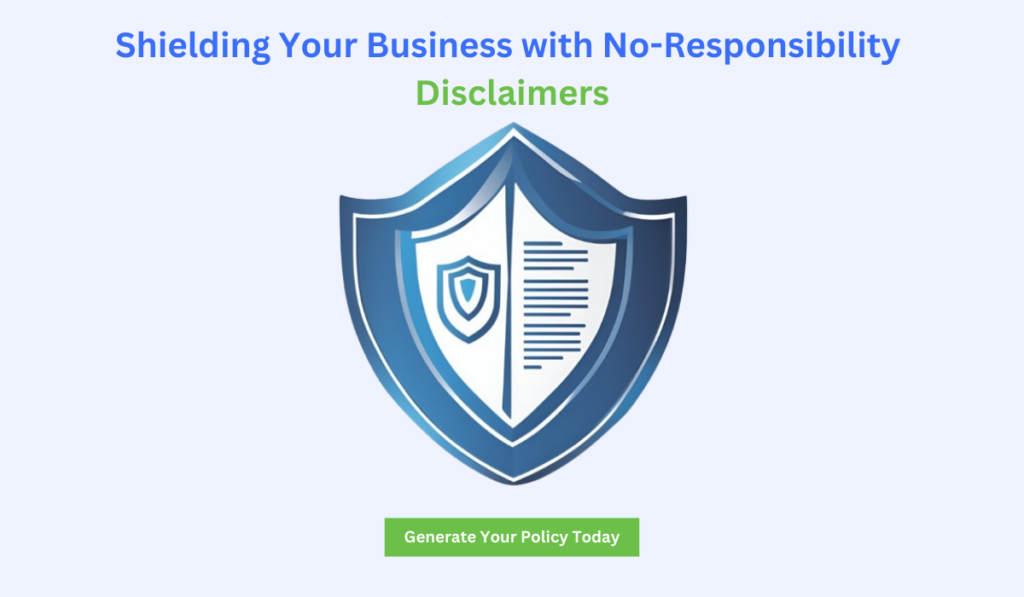No Responsibility Disclaimer
Running a business demands dedication, effort, and time to ensure growth and success. However, all your hard work could be in vain if you overlook potential legal risks. A no-responsibility disclaimer is like a life-saving jacket, protecting you from legal liabilities. You can consider it the simplest way to guard yourself against legal hacks. Let us dive in to know more about it!
Defining Non-responsibility Disclaimer
A no-responsibility disclaimer is a legal statement that limits your liability for any damages or losses arising from using your product or service.
You can understand it in the simplest way! Imagine something you want to do at your own risk, and the provider says I’m not the one to catch if anything goes wrong because you are doing it at your own risk.
The same goes with the no-responsibility disclaimer. It clearly states that you are not responsible for the damages that might happen due to using your product or service. Your hands are up and free!
Disclaimer of liability or No-liability Disclaimer
No-responsibility disclaimer is also known as disclaimer of liability or no-liability disclaimer. All these terms are mostly used interchangeably and carries the same meaning.
What should be covered in the No-Responsibility Disclaimer?
The disclaimer you write depends on the nature of your business, product, or service. It can be long or short. The points to add, again, depend on the requirements and nature of the product or service you have. Some points that you should keep in mind are:
- Goods can be tangible, for example, an object or item
- They can be intangible, for example, a service, advice, or piece of information
- They can be both; for example, a book that contains your ideas
Key Components of a Disclaimer:
- Use easy-to-understand words, not use any complex legal terms.
- Clearly state which part of your business the disclaimer applies, like products, services, or information.
- Mention what you are not responsible for, such as damages, mistakes, or missing information.
- Explain how users agree to protect you from legal claims related to their use of your product or service.
When to Use a No-Responsibility Disclaimer?
While disclaimers are valuable tools, they aren’t a magic solution. Use them judiciously in situations where:
- When there are inherent risks in products or services, like software, or financial advice.
- When you use third-party information or services.
- When there is a possibility that your product or service could be misused or abused.
Points of Protection
Most of the time, these disclaimers save you in the following ways:
- Protect the accuracy of information or content
- Protects in terms of physical liability
- Protects in terms of third-party links
Limitations of Disclaimers
It’s important to understand that disclaimers aren’t foolproof. They may not protect you from:
- It can intentionally or recklessly ignore important duties.
- It doesn’t keep promises about a product or service.
- Disclaimers can’t ignore essential rules that protect consumers.
Crucial information: It is imperative to note that these disclaimers doesn’t mean that you are allowed to become negligent and provide wrong and faulty information just to sell your product. It might harm the customer in many ways. You have to be responsible for your actions, especially if they are at fault by intention.
Who will use a No-responsibility disclaimer?
Anyone who sells, from small shopkeepers to high-tech merchants, from bloggers to online marketers, and from companies to warehouses. Anyone who provides a product to use owns the responsibility. He will need a disclaimer to meet the legal requirements.
Closing Thoughts
Even if your product is the best in town, it is better for you to just keep a No-responsibility disclaimer in your bucket. It is simply a safety sign against legalities in case of any uncertain event.
By understanding the purpose, components, and limitations of no-responsibility disclaimers, you can take proactive steps to safeguard your business.</span

